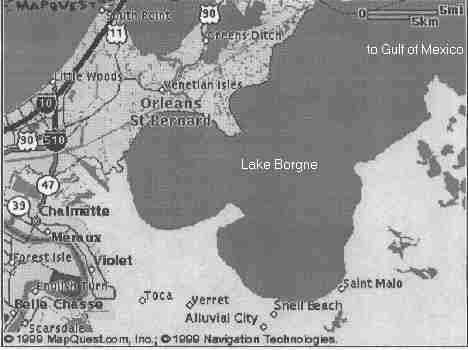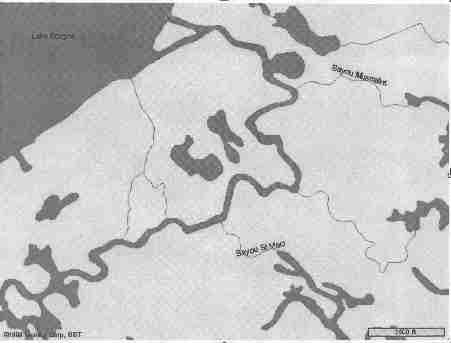
Click to find St Malo in the present day Map of New Orleans



copyright - click to view large picture-request permission for publication
For nearly fifty years there has existed in the southeastern swamp lands of Louisiana a certain strange settlement of Malay fishermen--Tagalas from the Philippine Islands. The place of their lacustrine village is not precisely mentioned upon maps, and the world in general ignored until a few days ago the bare fact of their aniphibious existence. Even the United States mail service has never found its way thither, and even in the great city of New Orleans, less than a hundred miles distant, the people were far better informed about the Carboniferous Era than concerning the swampy affairs of this Manila village.
Out of the shuddering reeds and banneretted grass on either side rise the fantastic houses of the Malay fishermen, posed upon slender supports above the marsh, like cranes or bitterns watching for scaly prey. Hard by the slimy mouth of the bayou extends a strange wharf, as ruined and rotted and unearthly as the timbers of the spectral ship in the "rim of the Ancient Mariner." Odd craft huddle together beside it, fishing-nets make cobwebby drapery about the skeleton timber - work. green are the banks, green the water is, green also with fungi every beam and plank and board and shingle of the houses upon stilts. All are built in true manila style, with immense hat shaped eaves and balconies, but in wood; for it had been found that palmetto and woven cane could not withstand the violence of the climate.
There were only about thirteen or fourteen large edifices on piles. The picture is composite of all the sketches made by the painter who accompanied the writer in 1883.
Possible the story is; probable it is not. Partly for the purpose of investigating it, but principally in order to offer HARPER's artist a totally novel subject of artistic study, the Times-Democrat of New Orleans chartered and fitted out an Italian lugger for a trip to the unexplored region in question--to the fishing station of Saint Malo. And a strange voyage it was. Even the Italian sailors knew not whither they were going. None of them had ever heard the Manila village, or were ever aware of its location..
This was St Malo. the first Filipino Settlement in America as written in March 1883.
Occasionally vague echoes of its mysterious life were borne to the civilized centre, but these were scarcely of a character to tempt investigation or encourage belief. Some voluble Italian luggermen and a long story regarding a ghastly "Chinese" colony in the reedy swamps south of Lake Borgne. For many years the inhabitants of the Oriental settlement had live in peace and harmony without the presence of a single woman, but finally had managed to import an oblique-eyed beauty from beyond the Yellow Sea. Thereupon arose the first dissensions, provoking much shedding of blood. And at last the elders of the people had restored clam and fraternal feeling by sentencing the woman to be hewn in pieces and flung to the alligators of the bayou.
Possible the story is; probable it is not. Partly for the purpose of investigating it, but principally in order to offer HARPER's artist a totally novel subject of artistic study, the Times-Democrat of New Orleans chartered and fitted out an Italian lugger for a trip to the unexplored region in question--to the fishing station of Saint Malo. And a strange voyage it was. Even the Italian sailors knew not whither they were going. None of them had ever heard the Manila village, or were ever aware of its location.
How to go there? It is almost the same way Lafcadio Hearn did it in 1883- by boat, crossing Lake Borgne to the southeastern section. It is soft marshland land and the environment of bayou just would not allow direct road access. Shell Beach, a tiny fishing commnunity, is located about five miles west of the Bayou of St Malo.
2280
miles from San Francisco
1900
miles from Los Angeles
1300
miles from New York
923
miles from Chicago
halfway
around the world from the Philippines.
For
the complete story click St MaloFull Story
(Harpers Weekly 1883 
Click
to find St Malo in the present day Map of New Orleans